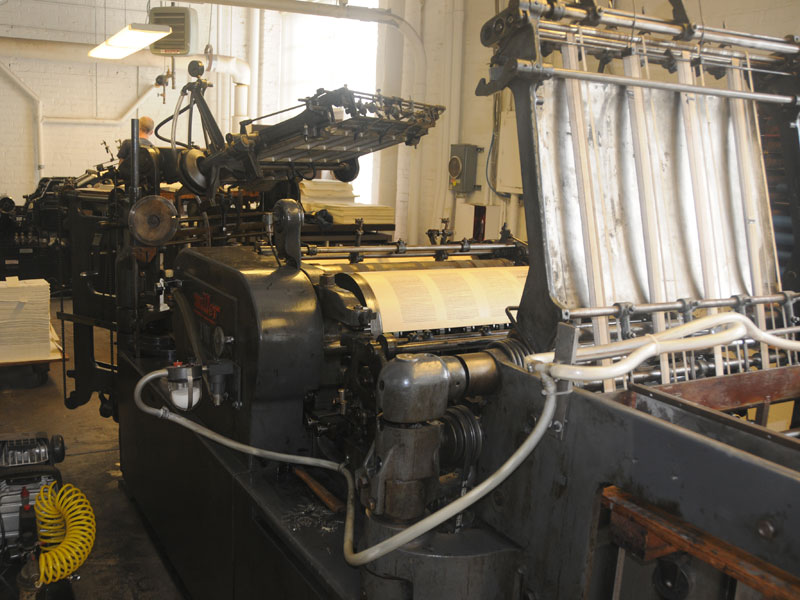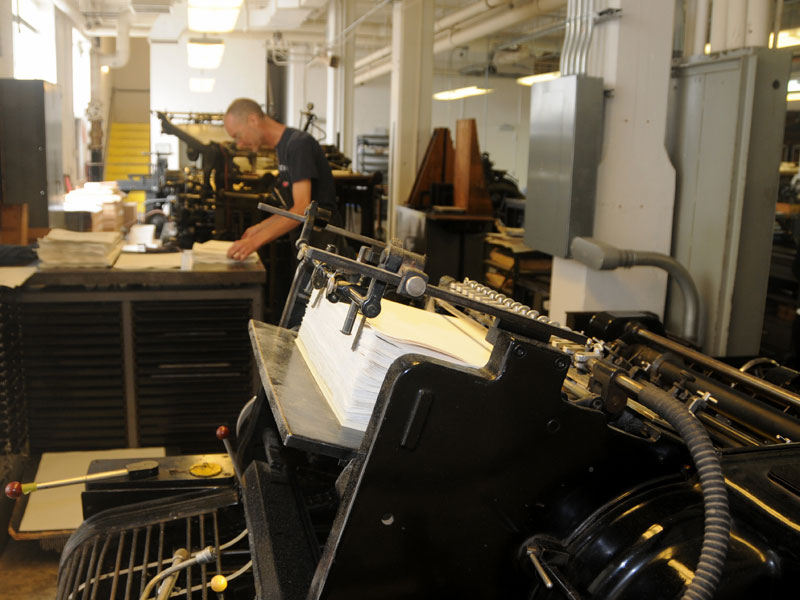In the press room, sheets for Stone from Delphi, an edition of poems with classical references by the Nobel Laureate Seamus Heaney with watercolor drawings by Wendy Artin were being printed on a Heidelberg cylinder press. Nearby stood the much larger two-color Miller cylinder press that is used for most Arion publications, and a Thomson Laureate platen press acquired from the Grabhorn Press, the machine used for the most celebrated Arion production of all, the 1979 edition of Moby-Dick printed on dampened Barcham Green hand-made paper, with one hundred wood engravings by Barry Moser.
On the ground floor, octogenarian Lewis Mitchell, a master typecaster who began learning the trade in 1950 at the age of eighteen, was working in the foundry with an apprentice, teaching him the finer points of what has clearly become a vanishing skill. Now known as M & H Type, the division sells type for letterpress and Monotype composition to printers worldwide. Modern applications are not neglected, with computer-generated typography and photopolymer platemaking also a part of the mix.
If anything is predictable about Hoyem’s publishing list, it is that subscribers can always expect to be surprised. Most titles are produced in limitations that rarely exceed three hundred numbered and twenty-six lettered copies. A few projects—most notably the Arion Lectern Bible—are produced in editions of four hundred copies, but those are the exceptions. Some books sell out quite quickly, Hoyem told me, while others will take a while. “In a perfect world, they’d all just walk out the door. Eventually they all sell out, but you have to be patient.”
Hoyem said he is able to produce new titles on a regular basis by having a core of customers who agree in advance to buy everything the press produces. When Hoyem began as a fine press printer and publisher in the 1960s, a good deal of that work was handled by dealers, but the dynamic has changed dramatically in recent years, forcing him to modify his marketing strategy.
“The Grabhorns sold very few books direct to customers, or direct to libraries, they sold to rare book dealers who then in turn marketed to their clientele. Now that’s all changed. The ground-level stores have all gone away, and booksellers have either moved upstairs to offices or into their homes, requiring us to do things differently. If we had relied on book dealers or bookstores to market our books, I’d have been out of business a long time ago.”
Hoyem said he keeps booksellers on his mailing list “so that they’re aware of what we’re doing,” and occasionally they will buy his books for stock, but for the most part sales these days are made directly to customers. “We have developed a group of subscribers that agree to buy all of our publications, unless we designate something like the Bible, which we priced bound at $7,750 a set, as optional. They get a thirty percent discount for making that commitment, but they can’t pick and choose.”
The National Trust for Historic Preservation has called the Arion Press an “irreplaceable historical and cultural legacy.” To assure its longevity, Hoyem has transferred ownership to a nonprofit organization he established in 2000, the Grabhorn Institute, named in honor of his mentors, the brothers Edwin and Robert Grabhorn. The institute also owns the foundry, maintains a gallery on the upper level, mounts regular exhibitions, organizes educational programs, and conducts public tours.
With publication of the imprint’s one-hundredth title looming on the horizon, Hoyem said he has no plans of slowing down. “I generally walk here every morning from my house,” he said of his daily routine. “It takes me about twenty minutes, and I always look forward to getting here.”











